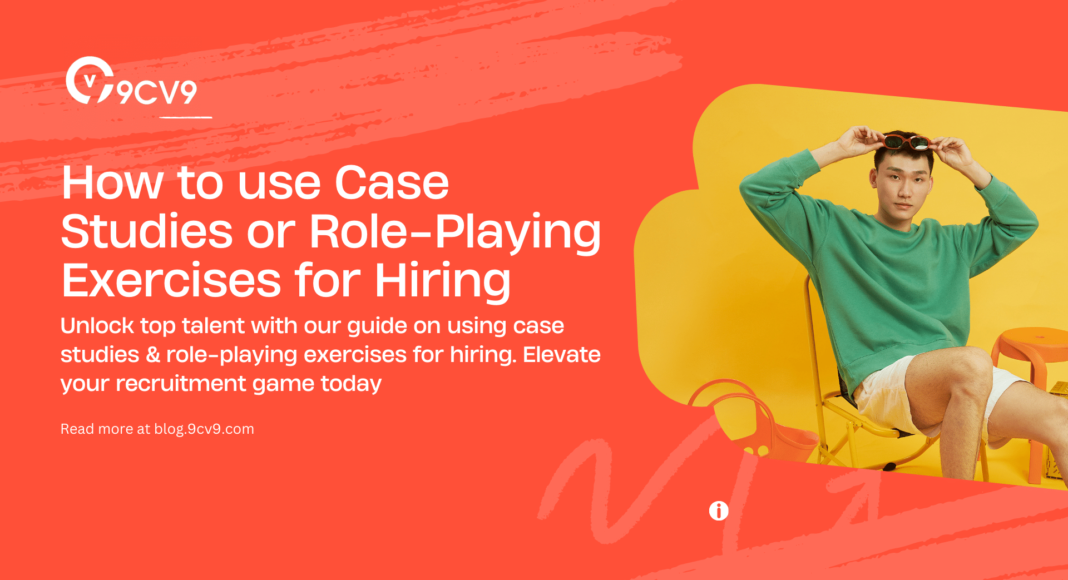Key Takeaways
- Elevate Your Hiring: Discover how case studies & role-playing exercises provide deeper insights into candidates’ skills & suitability, ensuring you recruit top talent.
- Uncover Hidden Potential: Harness the power of interactive assessments to identify diverse talent & mitigate biases, fostering a culture of inclusivity & meritocracy.
- Drive Organizational Success: Implementing case studies & role-playing exercises transforms recruitment, enabling you to build high-performing teams that propel your company forward.
In today’s fiercely competitive job market, the traditional methods of evaluating candidates’ skills and fit for a role often fall short.
As hiring managers and HR professionals seek innovative ways to identify top talent, the spotlight has increasingly turned to alternative assessment techniques.
Among these, case studies and role-playing exercises have emerged as dynamic tools that offer unparalleled insights into a candidate’s abilities, mindset, and potential contributions to the organization.

Welcome to our definitive guide on “How to use Case Studies or Role-Playing Exercises for Hiring.”
In this extensive exploration, we delve deep into the intricacies of incorporating these methodologies into your recruitment process, equipping you with the knowledge and strategies to make informed hiring decisions that drive organizational success.
But why are case studies and role-playing exercises garnering such widespread attention in the realm of talent acquisition?
The answer lies in their ability to transcend traditional interviews and resumes, providing a holistic view of a candidate’s capabilities and suitability for a role.
Unlike standard questions that often elicit rehearsed responses, these interactive assessments immerse candidates in real-world scenarios, prompting them to demonstrate their problem-solving skills, critical thinking abilities, and interpersonal aptitude in action.
Moreover, case studies and role-playing exercises offer a level playing field for candidates from diverse backgrounds and experiences.
By focusing on practical application rather than academic credentials or past job titles, these exercises enable hiring teams to uncover hidden talent and potential in individuals who may have been overlooked through conventional screening methods.
This not only enhances diversity and inclusivity within the workforce but also fosters a culture of meritocracy where candidates are evaluated based on their actual competencies rather than superficial factors.
In this guide, we will embark on a journey to understand the nuances of case studies and role-playing exercises, exploring their myriad benefits and practical applications in the hiring process.
From crafting compelling scenarios tailored to your organization’s needs to implementing robust evaluation frameworks that ensure fairness and objectivity, we leave no stone unturned in our quest to empower you with actionable insights and best practices.
But our exploration doesn’t stop there.
Drawing from real-life examples of companies that have successfully integrated these techniques into their recruitment strategies, we offer invaluable lessons and inspiration to guide you on your own hiring journey.
Additionally, we shine a light on common challenges and pitfalls that may arise along the way, equipping you with the knowledge to navigate obstacles with confidence and resilience.
Whether you’re a seasoned HR professional seeking to revitalize your hiring approach or a business leader looking to attract top talent in a competitive market, this guide is your ultimate companion in the quest for recruitment excellence.
So, join us as we unlock the secrets to mastering the art of hiring through the transformative power of case studies and role-playing exercises. Your journey to building a high-performing team starts here.
Before we venture further into this article, we like to share who we are and what we do.
About 9cv9
9cv9 is a business tech startup based in Singapore and Asia, with a strong presence all over the world.
With over eight years of startup and business experience, and being highly involved in connecting with thousands of companies and startups, the 9cv9 team has listed some important learning points in this overview of How to use Case Studies or Role-Playing Exercises for Hiring.
If your company needs recruitment and headhunting services to hire top-quality employees, you can use 9cv9 headhunting and recruitment services to hire top talents and candidates. Find out more here, or send over an email to [email protected].
Or just post 1 free job posting here at 9cv9 Hiring Portal in under 10 minutes.
How to use Case Studies or Role-Playing Exercises for Hiring
- Understanding Case Studies and Role-Playing Exercises
- The Benefits of Incorporating Case Studies and Role-Playing Exercises
- Crafting Effective Case Studies and Role-Playing Exercises
- Implementing Case Studies and Role-Playing Exercises in the Hiring Process
- Tips for Evaluating Performance and Making Informed Decisions
- Overcoming Common Challenges and Pitfalls
1. Understanding Case Studies and Role-Playing Exercises
In the realm of hiring, understanding the intricacies of case studies and role-playing exercises is essential for leveraging their full potential.
Let’s dive deep into what these methodologies entail and why they are integral components of modern recruitment strategies.

Defining Case Studies in Hiring
- What are case studies?: Case studies are immersive scenarios or hypothetical situations that mimic real-world challenges or projects relevant to the job role.
- Purpose: They are designed to assess a candidate’s problem-solving abilities, analytical skills, decision-making prowess, and aptitude for handling complex situations.
- Example: For a sales role, a case study might involve analyzing market data to develop a sales strategy for a new product launch, demonstrating the candidate’s understanding of market dynamics and strategic thinking.
Unpacking Role-Playing Exercises: What are They and Why are They Valuable?
- Understanding role-playing exercises: Role-playing exercises involve simulating workplace scenarios where candidates enact specific roles or interact with assessors in a simulated environment.
- Purpose: They provide insights into a candidate’s communication skills, emotional intelligence, adaptability, and ability to handle interpersonal dynamics.
- Example: In a customer service role, candidates may participate in a role-playing exercise where they engage with assessors acting as irate customers, demonstrating their ability to de-escalate conflicts and provide effective solutions.
The Psychology Behind Their Effectiveness
- Engagement: Case studies and role-playing exercises actively engage candidates by presenting them with challenges that require active participation and problem-solving.
- Behavioral assessment: They provide a glimpse into a candidate’s behavior under pressure, revealing how they approach challenges, collaborate with others, and adapt to changing circumstances.
- Authenticity: By mirroring real-world situations, these exercises create a more authentic and relevant assessment environment, allowing candidates to showcase their true abilities.
Understanding the underlying principles and methodologies of case studies and role-playing exercises is the first step toward harnessing their power in the hiring process.
Now, let’s explore the myriad benefits that these techniques offer and how they can elevate your recruitment strategy to new heights.
2. The Benefits of Incorporating Case Studies and Role-Playing Exercises
Integrating case studies and role-playing exercises into your hiring process offers a multitude of advantages, revolutionizing the way organizations assess and select candidates.

Let’s delve into the compelling benefits of leveraging these methodologies and how they can drive positive outcomes for your recruitment efforts.
Assessing Critical Thinking and Problem-Solving Skills
- Real-world application: Case studies provide candidates with practical challenges that require them to apply critical thinking and problem-solving skills in a realistic context.
- Depth of analysis: Candidates must analyze information, identify key issues, and formulate effective solutions, showcasing their ability to think analytically and strategically.
- Example: In a marketing role, a case study might require candidates to develop a comprehensive campaign strategy for a new product, demonstrating their capacity to devise creative solutions and anticipate market trends.
Gauging Interpersonal Skills and Cultural Fit
- Interactive assessment: Role-playing exercises simulate interpersonal interactions, allowing candidates to demonstrate their communication, collaboration, and conflict resolution skills.
- Cultural alignment: By observing candidates’ behavior and responses in simulated workplace scenarios, recruiters can assess their compatibility with the organization’s values and culture.
- Example: In a leadership position, a role-playing exercise might involve resolving a team conflict or conducting a performance review, providing insights into the candidate’s leadership style and interpersonal effectiveness.
Reducing Biases in the Hiring Process
- Objective evaluation: Case studies and role-playing exercises offer a structured framework for evaluating candidates’ performance based on observable behaviors and outcomes, minimizing the influence of subjective biases.
- Focus on merit: By emphasizing candidates’ demonstrated skills and competencies rather than superficial factors such as educational background or prior experience, these methodologies promote meritocracy in hiring.
- Example: An organization implementing case studies for hiring software engineers evaluates candidates based on their coding skills and problem-solving approach during a coding challenge, ensuring a fair and unbiased assessment regardless of educational pedigree.
Enhancing Candidate Engagement and Experience
- Interactive and engaging: Case studies and role-playing exercises provide candidates with an opportunity to actively participate in the assessment process, fostering engagement and investment in the hiring process.
- Positive candidate experience: Candidates appreciate the opportunity to showcase their skills in a practical and meaningful way, leading to a more positive overall experience with the organization.
- Example: A candidate participating in a role-playing exercise for a customer service role feels valued and engaged as they demonstrate their ability to handle customer inquiries and resolve issues effectively, leading to a favorable impression of the organization.
Incorporating case studies and role-playing exercises into your hiring process unlocks a myriad of benefits, from assessing critical skills to enhancing candidate engagement.
By embracing these methodologies, organizations can elevate their recruitment practices and identify top talent with confidence and precision.
3. Crafting Effective Case Studies and Role-Playing Exercises
Crafting compelling case studies and role-playing exercises is a critical aspect of integrating these methodologies into your hiring process successfully.
By designing scenarios that are relevant, challenging, and reflective of the role’s requirements, you can elicit meaningful insights into candidates’ capabilities.

Let’s explore the key considerations and best practices for crafting effective case studies and role-playing exercises.
Identifying the Skills and Traits You Want to Evaluate
- Alignment with job requirements: Begin by identifying the specific skills, competencies, and traits essential for success in the role.
- Tailored scenarios: Craft case studies and role-playing exercises that directly assess these identified skills and traits, ensuring relevance and applicability.
- Example: For a project management position, case studies might focus on evaluating candidates’ ability to prioritize tasks, manage stakeholders, and navigate unforeseen challenges within project timelines.
Designing Realistic Scenarios Relevant to the Role
- Contextual relevance: Develop case studies and role-playing exercises that reflect the challenges and scenarios candidates are likely to encounter in the actual role.
- Authenticity: Ensure that the scenarios mirror real-world situations as closely as possible, providing candidates with a realistic simulation of the job environment.
- Example: In a sales role, a role-playing exercise could involve conducting a mock sales presentation to a prospective client, simulating the challenges and dynamics of a typical sales interaction.
Establishing Clear Evaluation Criteria
- Objective assessment: Define clear and specific evaluation criteria that align with the objectives of the case study or role-playing exercise.
- Quantifiable metrics: Identify measurable outcomes or behaviors that indicate successful performance in the given scenario.
- Example: In a case study assessing problem-solving skills, evaluation criteria might include the candidate’s ability to identify key issues, analyze data, propose solutions, and justify their recommendations.
Ensuring Fairness and Inclusivity
- Accessibility: Ensure that case studies and role-playing exercises are accessible to all candidates, regardless of background or experience.
- Mitigating bias: Take steps to minimize the influence of unconscious bias in the design and evaluation of exercises, promoting fairness and objectivity.
- Example: Provide candidates with clear instructions and guidelines for completing case studies and role-playing exercises, accompanied by resources and support to level the playing field for all participants.
Crafting effective case studies and role-playing exercises requires careful consideration of the skills to be evaluated, contextual relevance, clear evaluation criteria, and a commitment to fairness and inclusivity.
By following these best practices and incorporating relevant examples, you can create assessment tools that provide valuable insights into candidates’ capabilities and suitability for the role.
4. Implementing Case Studies and Role-Playing Exercises in the Hiring Process
Integrating case studies and role-playing exercises into your hiring process requires careful planning and execution to ensure seamless implementation and meaningful evaluation of candidates.
Let’s explore the steps involved in incorporating these methodologies effectively and maximizing their impact on your recruitment efforts.
Introducing Case Studies and Role-Playing Exercises into the Recruitment Timeline
- Strategic placement: Determine the appropriate stage of the hiring process to introduce case studies and role-playing exercises, considering factors such as candidate volume, time constraints, and the complexity of the role.
- Early screening: Consider using case studies or role-playing exercises as part of the initial screening process to assess candidates’ problem-solving skills and suitability for the role before progressing to subsequent stages.
- Example: A technology company incorporates a coding challenge as the first step in its hiring process for software engineers, allowing recruiters to evaluate candidates’ technical proficiency before scheduling interviews.
Communicating Expectations to Candidates
- Transparency: Clearly communicate to candidates the purpose, format, and expectations of the case studies or role-playing exercises, ensuring they understand what is being assessed and how their performance will be evaluated.
- Preparation guidelines: Provide candidates with any necessary instructions, resources, or materials to prepare for the exercises, enabling them to perform at their best.
- Example: An organization hosting a group role-playing exercise for a leadership position provides candidates with a detailed overview of the scenario and expectations for their participation, along with relevant background information to aid in preparation.
Providing Necessary Resources and Support
- Technical assistance: Ensure that candidates have access to the technology or tools required to complete case studies or role-playing exercises smoothly, and offer technical support if needed.
- Feedback mechanisms: Establish channels for candidates to seek clarification or assistance during the exercises, and provide prompt feedback following completion to facilitate learning and improvement.
- Example: A company conducting a virtual case study exercise for marketing candidates offers a practice session beforehand to familiarize candidates with the platform and troubleshoot any technical issues, ensuring a smooth experience on the assessment day.
Leveraging Technology for Seamless Execution
- Online platforms: Utilize specialized software or platforms designed for administering and evaluating case studies and role-playing exercises remotely, enhancing efficiency and accessibility for both candidates and assessors.
- Virtual collaboration tools: Leverage virtual collaboration tools and video conferencing platforms to facilitate real-time interaction and observation during role-playing exercises, regardless of geographical location.
- Example: A multinational corporation conducts virtual role-playing exercises for sales positions using a combination of video conferencing software and collaborative document editing tools, enabling candidates and assessors to interact seamlessly across different time zones.
Implementing case studies and role-playing exercises in the hiring process requires careful planning, clear communication, and the effective use of technology.
By following these best practices and leveraging relevant examples, you can create a streamlined and impactful assessment experience that helps identify top talent and drive organizational success.
5. Tips for Evaluating Performance and Making Informed Decisions
Evaluating candidate performance in case studies and role-playing exercises is a crucial step in the hiring process, requiring a structured approach and effective decision-making strategies.
Let’s explore key tips and best practices for evaluating performance and making informed hiring decisions that drive organizational success.
Developing a Structured Evaluation Rubric
- Clear criteria: Define specific evaluation criteria aligned with the objectives of the case studies or role-playing exercises, ensuring consistency and objectivity in assessment.
- Scoring methodology: Establish a scoring system or rubric that quantifies performance based on observable behaviors, outcomes, or competencies.
- Example: For a case study assessing problem-solving skills, the evaluation rubric may include criteria such as the candidate’s ability to identify key issues, analyze data, propose solutions, and justify their recommendations, each assigned a weighted score.
Training Interviewers and Evaluators
- Consistent standards: Provide training and guidance to interviewers and evaluators on how to use the evaluation rubric effectively and apply consistent standards when assessing candidate performance.
- Mock assessments: Conduct practice sessions or mock assessments to familiarize evaluators with the assessment process and ensure alignment in scoring and feedback.
- Example: A hiring team for a customer service role undergoes training on using the evaluation rubric to assess candidates’ communication skills and problem-solving abilities during role-playing exercises, enhancing consistency and reliability in evaluation.
Balancing Quantitative and Qualitative Assessment
- Quantifiable metrics: Use quantitative data and metrics derived from the evaluation rubric to assess candidates’ performance objectively and compare their proficiency across different criteria.
- Qualitative observations: Incorporate qualitative observations and feedback from evaluators to provide context and depth to the assessment, capturing nuances and soft skills that may not be easily quantifiable.
- Example: While assessing a candidate’s performance in a leadership role-playing exercise, quantitative metrics such as effective communication and decision-making skills may be complemented by qualitative feedback on their ability to inspire and motivate team members.
Incorporating Feedback into the Decision-Making Process
- Iterative process: Gather feedback from interviewers, evaluators, and other stakeholders involved in the assessment process to identify strengths, areas for improvement, and insights into candidates’ suitability for the role.
- Data-driven decisions: Use the collected feedback and evaluation data as a basis for making informed hiring decisions, weighing candidates’ performance against the predefined criteria and organizational priorities.
- Example: Following a series of case studies and role-playing exercises for a project management position, the hiring team convenes to review assessment scores, discuss candidate performance, and collaboratively decide on the most qualified candidate based on the evaluation criteria and feedback.
Evaluating performance in case studies and role-playing exercises requires a structured approach, effective training, and a balance between quantitative and qualitative assessment methods.
By following these tips and leveraging relevant examples, organizations can make informed hiring decisions that align with their objectives and drive success in talent acquisition.
6. Overcoming Common Challenges and Pitfalls
Navigating through challenges and pitfalls is an inevitable part of incorporating case studies and role-playing exercises into the hiring process.
However, with careful planning and proactive strategies, organizations can overcome these obstacles and ensure a successful implementation.
Let’s explore some common challenges and effective ways to overcome them.
Addressing Resistance from Stakeholders
- Educational efforts: Provide comprehensive education and training to stakeholders, including hiring managers, interviewers, and senior leadership, on the benefits and rationale behind using case studies and role-playing exercises in the hiring process.
- Demonstrating value: Showcase success stories and case studies of other organizations that have effectively implemented these methodologies, highlighting the positive outcomes and impact on hiring quality.
- Example: A company facing resistance from hiring managers regarding the introduction of case studies conducts workshops and presentations to illustrate how these exercises provide deeper insights into candidates’ skills and suitability for the role, eventually winning over stakeholders’ support.
Dealing with Logistical and Resource Constraints
- Efficient use of resources: Prioritize essential resources such as time, budget, and personnel to support the implementation of case studies and role-playing exercises, focusing on areas where they can have the most significant impact.
- Streamlined processes: Optimize the assessment process to minimize logistical complexities and resource requirements, leveraging technology and automation where possible.
- Example: A startup with limited resources for recruitment adopts a streamlined approach to case studies by developing standardized templates and evaluation rubrics, allowing them to assess candidates efficiently without significant investment.
Mitigating Potential Biases in Evaluation
- Structured assessment: Implement a structured evaluation process with predefined criteria and rubrics to minimize the influence of unconscious biases in assessing candidate performance.
- Diverse evaluation panel: Ensure diversity and representation among evaluators to bring different perspectives and mitigate the impact of individual biases.
- Example: An organization striving for diversity and inclusion in its hiring process forms evaluation panels comprising members from diverse backgrounds and experiences, reducing the risk of bias and promoting fairness in assessment.
Managing Candidate Experience and Expectations
- Clear communication: Maintain transparency and clarity in communicating with candidates about the assessment process, expectations, and timelines, ensuring they understand the purpose and significance of case studies and role-playing exercises.
- Feedback and support: Provide constructive feedback to candidates following their participation in case studies or role-playing exercises, offering guidance and support to help them improve and grow from the experience.
- Example: A company implementing case studies for a management role establishes a feedback mechanism to provide personalized feedback to candidates, helping them understand their strengths and areas for development and fostering a positive candidate experience.
By proactively addressing common challenges and pitfalls, organizations can overcome obstacles and unlock the full potential of case studies and role-playing exercises in their hiring process.
With strategic planning, effective communication, and a commitment to continuous improvement, these methodologies can become invaluable tools for identifying top talent and driving organizational success.
Conclusion
In the ever-evolving landscape of talent acquisition, organizations are constantly seeking innovative methods to identify and attract top talent who can drive organizational success.
Among the myriad strategies and techniques available, case studies and role-playing exercises have emerged as powerful tools for assessing candidates’ skills, competencies, and cultural fit in a dynamic and interactive manner.
Throughout this comprehensive guide on “How to use Case Studies or Role-Playing Exercises for Hiring,” we’ve explored the nuances of these methodologies, delving into their definition, benefits, implementation strategies, and best practices.
From crafting compelling scenarios to evaluating candidate performance and overcoming common challenges, we’ve provided actionable insights and guidance to help organizations harness the full potential of case studies and role-playing exercises in their recruitment process.
By incorporating case studies and role-playing exercises into the hiring process, organizations can unlock a host of benefits, including the ability to assess critical thinking, problem-solving skills, interpersonal aptitude, and cultural fit with unparalleled depth and authenticity.
These methodologies transcend traditional interviews and resumes, providing a holistic view of candidates’ abilities and potential contributions to the organization.
Moreover, case studies and role-playing exercises offer a level playing field for candidates from diverse backgrounds and experiences, promoting fairness, inclusivity, and meritocracy in the recruitment process.
By focusing on practical application rather than superficial factors, organizations can uncover hidden talent and identify candidates who possess the skills and traits essential for success in the role.
As we conclude this guide, it’s essential to emphasize the transformative impact that case studies and role-playing exercises can have on talent acquisition when implemented effectively.
By embracing innovation, adopting best practices, and continuously refining their approach, organizations can elevate their recruitment strategies, attract top talent, and build high-performing teams that drive organizational growth and success.
In the competitive landscape of talent acquisition, the ability to identify and hire the right candidates is paramount.
With case studies and role-playing exercises as valuable tools in their arsenal, organizations can embark on a journey of recruitment excellence, ensuring that they not only find the best talent but also create a positive and engaging candidate experience that reflects their commitment to excellence and innovation.
As you embark on your recruitment journey, remember that case studies and role-playing exercises are not just assessments; they’re opportunities to uncover hidden potential, foster diversity and inclusion, and ultimately, build a workforce that propels your organization toward its goals.
Embrace the power of case studies and role-playing exercises, and watch as your recruitment process transforms into a strategic advantage in the competitive marketplace.
If your company needs HR, hiring, or corporate services, you can use 9cv9 hiring and recruitment services. Book a consultation slot here, or send over an email to [email protected].
If you find this article useful, why not share it with your hiring manager and C-level suite friends and also leave a nice comment below?
We, at the 9cv9 Research Team, strive to bring the latest and most meaningful data, guides, and statistics to your doorstep.
To get access to top-quality guides, click over to 9cv9 Blog.
People Also Ask
How can case studies benefit the hiring process?
Case studies provide real-world scenarios for candidates to showcase skills, offering deeper insights into their problem-solving abilities and suitability for the role.
What are role-playing exercises in hiring?
Role-playing exercises simulate workplace scenarios, assessing candidates’ communication, interpersonal skills, and ability to handle challenges in a simulated environment.
How do case studies assess critical thinking?
Case studies present candidates with complex problems, evaluating their ability to analyze information, identify key issues, and propose effective solutions.
What skills can role-playing exercises assess?
Role-playing exercises gauge candidates’ interpersonal skills, emotional intelligence, adaptability, and ability to handle real-world situations with finesse.
How can I create effective case studies for hiring?
Craft case studies that align with the job role, featuring realistic scenarios and clear evaluation criteria to accurately assess candidates’ skills and competencies.
What are the benefits of using role-playing exercises in recruitment?
Role-playing exercises provide a more authentic assessment of candidates’ abilities, offering insights into their behavior, communication style, and problem-solving approach.
How do I implement case studies in the hiring process?
Introduce case studies at relevant stages of the recruitment process, communicate expectations clearly to candidates, and provide necessary resources and support.
What role do case studies play in assessing problem-solving skills?
Case studies challenge candidates to apply their problem-solving skills in practical contexts, demonstrating their ability to think critically and propose viable solutions.
How can I ensure fairness when using case studies for hiring?
Establish clear evaluation criteria, train evaluators to apply consistent standards, and mitigate bias by focusing on observable behaviors and outcomes.
What is the purpose of incorporating role-playing exercises in hiring?
Role-playing exercises assess candidates’ interpersonal skills, communication abilities, and cultural fit, providing a more holistic evaluation of their suitability for the role.
How do I design realistic role-playing exercises for hiring?
Develop role-playing scenarios that mirror workplace challenges, incorporate relevant dynamics, and provide candidates with an authentic simulation of the job environment.
Can case studies help identify cultural fit?
Yes, case studies can assess candidates’ alignment with organizational values, problem-solving approach, and decision-making processes, offering insights into cultural fit.
What role do evaluation rubrics play in assessing candidate performance?
Evaluation rubrics provide a structured framework for assessing candidates’ performance based on predefined criteria, ensuring consistency and objectivity in evaluation.
How do I train interviewers to evaluate case study performance effectively?
Provide training on using evaluation rubrics, conduct practice sessions, and emphasize the importance of applying consistent standards when assessing candidate performance.
How do I balance quantitative and qualitative assessment in role-playing exercises?
Combine quantitative metrics derived from evaluation rubrics with qualitative observations and feedback to provide a comprehensive assessment of candidates’ performance.
Can role-playing exercises help identify leadership potential?
Yes, role-playing exercises can simulate leadership scenarios, allowing candidates to demonstrate their ability to lead, influence, and motivate others in a simulated environment.
How do I ensure candidates have a positive experience with case studies?
Maintain transparency in communication, provide clear instructions and support resources, and offer constructive feedback to candidates following their participation.
What challenges may arise when implementing case studies for hiring?
Common challenges include resistance from stakeholders, logistical constraints, biases in evaluation, and managing candidate expectations and experience.
How do I overcome resistance from hiring managers regarding case studies?
Educate stakeholders on the benefits of case studies, share success stories, and demonstrate how these methodologies enhance hiring quality and identify top talent.
Can case studies be adapted for different job roles and industries?
Yes, case studies can be tailored to suit diverse job roles and industries, ensuring relevance and applicability to the specific requirements of each position.
How do I measure the effectiveness of case studies and role-playing exercises in hiring?
Evaluate the impact on hiring quality, candidate experience, and organizational success metrics such as retention rates and performance outcomes to measure effectiveness.
How do I mitigate biases in evaluating role-playing exercises?
Diversify evaluation panels, establish clear evaluation criteria, and focus on observable behaviors and outcomes rather than subjective impressions or assumptions.
How do I communicate the purpose of role-playing exercises to candidates?
Clearly explain the rationale behind role-playing exercises, emphasizing their importance in assessing interpersonal skills, communication abilities, and cultural fit.
Can role-playing exercises be conducted remotely?
Yes, role-playing exercises can be adapted for remote assessment using video conferencing platforms and virtual collaboration tools, ensuring accessibility and flexibility.
How do I ensure candidates are prepared for role-playing exercises?
Provide candidates with information about the format, expectations, and resources for preparation, allowing them to feel confident and prepared for the assessment.
How do I ensure consistency in evaluating case study performance?
Establish calibration sessions for evaluators, review sample responses, and discuss interpretation of evaluation criteria to ensure consistency and reliability in assessment.
How do I incorporate candidate feedback into the assessment process?
Gather feedback from candidates about their experience with case studies or role-playing exercises, use it to improve the assessment process, and demonstrate a commitment to continuous improvement.
Can case studies reveal candidates’ potential for innovation?
Yes, case studies can assess candidates’ creativity, innovation, and ability to think outside the box, providing insights into their potential to drive innovation within the organization.































![Writing A Good CV [6 Tips To Improve Your CV] 6 Tips To Improve Your CV](https://blog.9cv9.com/wp-content/uploads/2020/06/2020-06-02-2-100x70.png)


